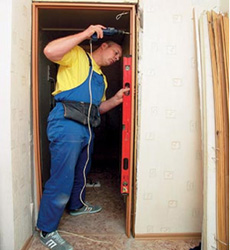Installation of veneered doors.
 Veneer is a thin sheet of natural wood, approximately 0.5-0.65 mm thick, glued to a wooden base and covered with a layer of varnish. Doors finished with this material are usually very difficult to distinguish from expensive ones made of solid solid wood.
Veneer is a thin sheet of natural wood, approximately 0.5-0.65 mm thick, glued to a wooden base and covered with a layer of varnish. Doors finished with this material are usually very difficult to distinguish from expensive ones made of solid solid wood.
The design of veneered doors is similar to that of laminated doors: a pine frame finished with MDF sheets and a layer of finishing material pasted on top of them. Only on top they are finished not with laminate, but with natural veneer, which makes them more beautiful and eco-friendly, natural-looking. Due to some of its features, veneered doors can be even more reliable and durable than doors made of solid solid wood.
The main advantages of veneered doors include aesthetics (the use of veneer makes it possible to create many beautiful models for every taste), sound and thermal insulation and tightness when closed, an optimal price-quality ratio (they are much cheaper than solid wood doors, but they serve longer), resistance to long-term operation (doors made of natural veneer are not afraid of such factors as drying and corrosion).
It is necessary to install veneered doors in compliance with a number of conditions:
First, make sure that the gap between the door leaf and the box is about 4-5 mm. This is important, because veneered doors are made of inexpensive solid wood, covered with natural wood veneer, and such an array is subject to the influence of humidity changes.
Secondly, the installation of veneered doors should be carried out exclusively with a sharp power tool. This will allow you to avoid chipping, which is very noticeable on veneered doors. If a chip does happen, the veneered door is amenable to restoration, but it's much nicer to avoid additional difficulties, isn't it?
Third, if you install doors in a room with high humidity (bathroom, toilet or kitchen), it is extremely important to carefully treat the places where the fittings are inserted and the places where the box comes into contact with the floor with a special sealant, drying oil or varnish. If you do not do this, then soon the moisture that has fallen on these places will lead to peeling of the veneer.
Such sensitivity to moisture is the main disadvantage of veneered doors. Of course, no one forbids installing such doors in bathrooms, but you need to understand well that if the condensate that settles as a result of temperature changes, such doors withstand well, then direct exposure to water can lead to peeling of the veneered coating.
Next article: Door care.
Pub date: 2021.06.01